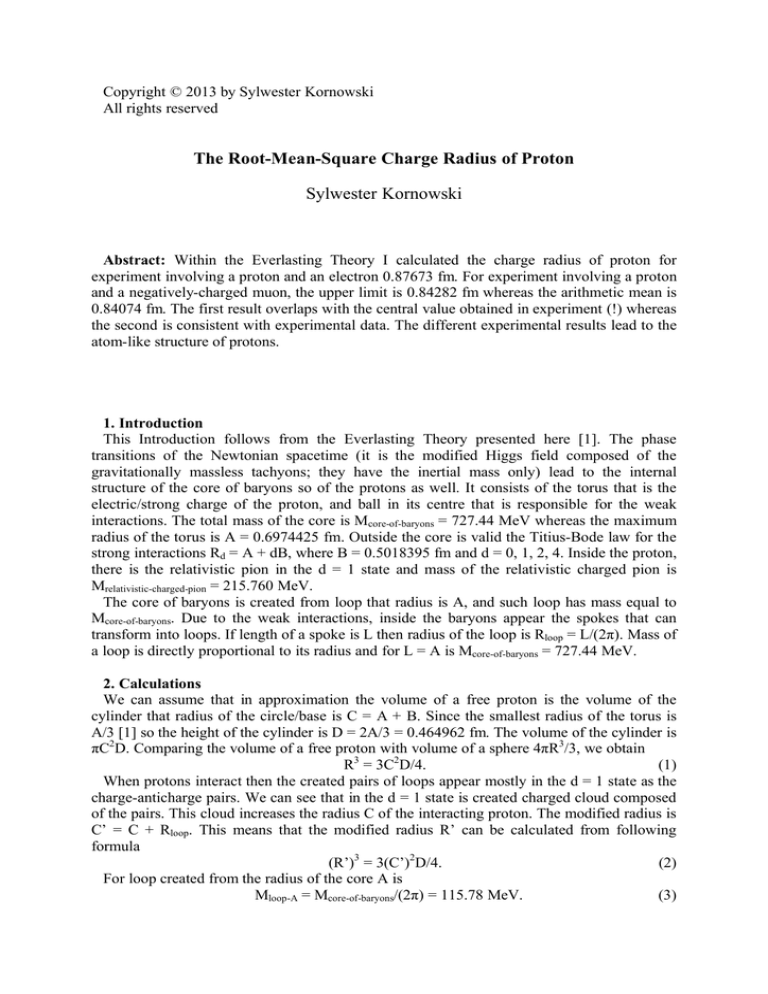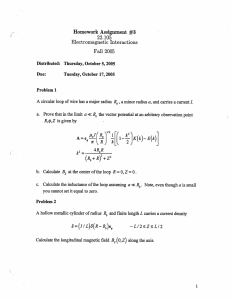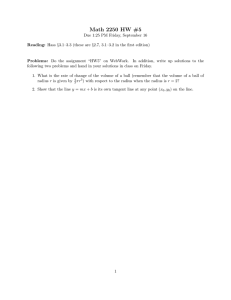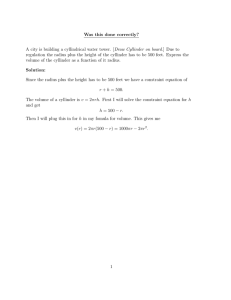
Copyright © 2013 by Sylwester Kornowski
All rights reserved
The Root-Mean-Square Charge Radius of Proton
Sylwester Kornowski
Abstract: Within the Everlasting Theory I calculated the charge radius of proton for
experiment involving a proton and an electron 0.87673 fm. For experiment involving a proton
and a negatively-charged muon, the upper limit is 0.84282 fm whereas the arithmetic mean is
0.84074 fm. The first result overlaps with the central value obtained in experiment (!) whereas
the second is consistent with experimental data. The different experimental results lead to the
atom-like structure of protons.
1. Introduction
This Introduction follows from the Everlasting Theory presented here [1]. The phase
transitions of the Newtonian spacetime (it is the modified Higgs field composed of the
gravitationally massless tachyons; they have the inertial mass only) lead to the internal
structure of the core of baryons so of the protons as well. It consists of the torus that is the
electric/strong charge of the proton, and ball in its centre that is responsible for the weak
interactions. The total mass of the core is Mcore-of-baryons = 727.44 MeV whereas the maximum
radius of the torus is A = 0.6974425 fm. Outside the core is valid the Titius-Bode law for the
strong interactions Rd = A + dB, where B = 0.5018395 fm and d = 0, 1, 2, 4. Inside the proton,
there is the relativistic pion in the d = 1 state and mass of the relativistic charged pion is
Mrelativistic-charged-pion = 215.760 MeV.
The core of baryons is created from loop that radius is A, and such loop has mass equal to
Mcore-of-baryons. Due to the weak interactions, inside the baryons appear the spokes that can
transform into loops. If length of a spoke is L then radius of the loop is Rloop = L/(2π). Mass of
a loop is directly proportional to its radius and for L = A is Mcore-of-baryons = 727.44 MeV.
2. Calculations
We can assume that in approximation the volume of a free proton is the volume of the
cylinder that radius of the circle/base is C = A + B. Since the smallest radius of the torus is
A/3 [1] so the height of the cylinder is D = 2A/3 = 0.464962 fm. The volume of the cylinder is
πC2D. Comparing the volume of a free proton with volume of a sphere 4πR3/3, we obtain
R3 = 3C2D/4.
(1)
When protons interact then the created pairs of loops appear mostly in the d = 1 state as the
charge-anticharge pairs. We can see that in the d = 1 state is created charged cloud composed
of the pairs. This cloud increases the radius C of the interacting proton. The modified radius is
C’ = C + Rloop. This means that the modified radius R’ can be calculated from following
formula
(R’)3 = 3(C’)2D/4.
(2)
For loop created from the radius of the core A is
Mloop-A = Mcore-of-baryons/(2π) = 115.78 MeV.
(3)
2
This mass is close to the mass of the muon and probability of creation of such loops is
higher than the loops corresponding to the mass of muon. This follows from the fact that the
structure of the core of baryons dominates in the interactions of baryons. It means that for
muon interacting with proton we obtain
Rloop-muon-maximum = A/(2π) = 0.1110014 fm.
(4)
Now we can calculate the root-mean-square charge radii of protons, which should be equal
to R’, for different initial conditions. For protons interacting with muons we obtain
C’proton-muon-maximum = 1.31028 fm so R’proton-muon-maximum = 0.84282 fm and this radius is only
0.037% above the upper limit defined in following experiment [2]. There dominates the atomlike structure of baryons but there can appear the loops corresponding to the exact mass of the
interacting (not free) muon with the core of baryons: Mmuon = 105.6670 MeV [1]. Such loop
has following radius
Rloop-muon-minimum = AMmuon/Mcore-of-baryons = 0.1013096 fm.
(5)
For such loop we obtain C’proton-muon-minimum = 1.30059 fm so R’proton-muon-minimum = 0.83866
fm. It is the lower limit. The arithmetic mean is (R’proton-muon-maximum + R’proton-muon-minimum)/2 =
0.84074 fm but since there dominates the atom-like structure of baryons, it should not be the
central value.
The electrons interact with the most distant electric charge i.e. with the relativistic charged
pion in the d = 1 state. Radius of orbit for such pion is C = A + B. This means that there are
produced loops that radius is
Rloop-electron = (A + B)/(2π) = 0.1908717 fm.
(6)
For protons interacting with electrons we obtain C’proton-electron = 1.390154 fm. This leads to
R’proton-electron = 0.87673 fm and this radius is the central value (!) obtained in following
experiment [3].
3. Summary
Within the Everlasting Theory I calculated the charge radius of proton for experiment
involving a proton and an electron 0.87673 fm. For experiment involving a proton and a
negatively-charged muon, the upper limit is 0.84282 fm whereas the arithmetic mean is
0.84074 fm. The first result overlaps with the central value obtained in experiment (!) whereas
the second is consistent with experimental data.
We obtained the theoretical results consistent with the two experiments for the distances A,
and A + B. We can see that the different experimental results lead to the atom-like structure of
protons.
References
[1] S. Kornowski (2012). “The Everlasting Theory and Special Number Theory”.
http://www.rxiv.org/abs/1203.0021 [v2].
[2] http://www.azonano.com/news.aspx?newsID=18428
[3] Randolf Pohl, Aldo Antognini, François Nez, Fernando D. Amaro, François Biraben,
Joao M. R. Cardoso, Daniel S. Covita, Andreas Dax, Satish Dhawan, Luis M. P.
Fernandes, Adolf Giesen, Thomas Graf, Theodor W. Hänsch, Paul Indelicato, Lucile
Julien, Cheng-Yang Kao, Paul Knowles, Eric-Olivier Le Bigot, Yi-Wei Liu, José A. M.
Lopes, Livia Ludhova, Cristina M. B. Monteiro, Françoise Mulhauser, Tobias Nebel,
Paul Rabinowitz, et al. (8 July 2010). "The size of the proton".
Nature 466 (7303): 213–216. Bibcode 2010Natur.466..213P. doi:10.1038/nature09250.
PMID 20613837.
http://www.nature.com/nature/journal/v466/n7303/abs/nature09250.html. Retrieved
2010-07-09.



